#Marpha
Explore tagged Tumblr posts
Text
安娜普納大環線,Jomsom - Marpha - Larjung

昨天已經去過Thini村,今天就想走不一樣的路線去Marpha,可以不用繞去Thini和Dhumba Lake,距離比較短。
結果這條路走的人很少,一開始還走在人家的排屋中間,後來在河邊走了一段,看起來只有一條橋過河,地圖上第二條似乎不存在。


我在河床的幾個角度都看不到第二條橋,走到河床叉路又沒路了,還好遇到個當���人,她建議我回去過第一條橋。過了橋我又照地圖下河床,這次也有好心人在上面喊住我,說再過去太危險,要我回去走上面馬路,原來這裡是河流轉彎處,河床有點改變了,maps.me上的線路已經不通。



���後過了大橋後,自然有健行指標又可以回去河床走,不用跟車子爭搶飛揚的黃沙了。
我本來想天氣冷就晚點出發,反正今天只想走到Marpha,距離也不遠,沒想到沒走多久將近中午就起風,頂著風在河谷裡的確不太好走。


Jomsom - Marpha,7公里,3.5小時。
這是個佛教的歷史村落,公路並沒有穿過村莊,所以傳統建築都還保持著,很多尼泊爾人還特別跑來這個小村穿起藏服拍起網美照呢!



村子不大,最熱鬧的就短短一條石板街,不過爬上monastery的視野不錯,整個村都是舊建築,每家屋頂堆滿木材,看了就舒服。



住宿:Hotel Sunrise,房間400rs
費用:午餐 (chicken momo) 350rs + 茶 (lemon tea) 100rs + 晚餐 (mushroom pizza) 700rs,早餐 (Tibetan bread w honey+coffee) 570rs

隔天研究了一下地圖,因為我想去Larjung附近的兩個湖看看,所以預計在Larjung過夜,這樣的話徒步小徑過了Chimrang就得過河,走Tukuche這側。



這段路風景不錯,不過今天還不到十一點就起風了,是那種大到過長吊橋都會有點怕的風。
頂風走路有點辛苦,才走兩小時就感覺累了。撐到Tukuche要停下來吃飯,到不是肚子有多餓,而是需要背包下肩休息一會。



Marpha - Tukuche,8公里,2.5小時。
在鎮上隨便找間旅館吃飯,現在公路開通後走這裡的人很少,村子很冷清。


地圖上過了Tukuche後也有徒步小徑,結果我跟著地圖又走到河道上,河道上風好大,走了好一會正在建的堤防,最後竟然只剩下石頭車道印。後來風沙大到有時前方的路跡都看不清楚,走越不放心,趕緊找到路口彎上公路,沿著公路頂著風走了好一段才到Larjung。


Tukuche - Larjung,4公里,1.5小時。
這裡可以很清楚看到世界第七高的道拉吉里峰(Dhaulagiri),我一樣是習慣走去舊的老村子裡找住宿。



最後落腳在村尾,晚上大氣地點了份量多的晚餐和隔天早餐,要給自己吃飽有體力,不然頂風走路很耗巧克力。


住宿:Larjung Lodge and Thakali Kitchen,房間400rs
費用:午餐 (veg fried noodles) 400rs + 茶 (lemon ginger honey) 120rs + 晚餐 (Larjun pizza) 700rs,早餐 (apple porridge+lemon sugar pancake+coffee) 820rs
0 notes
Text
drafts of critters for one of my stories




+versions with hair because they are supposed to be anthro in the final design
#doodle#oc stuff#codename: 9 lives#didnt name that story yet#their names are Marpha and Eva#designs not final#names not final either
2 notes
·
View notes
Text
now THATS the creepypasta oc i wanted to see from the beginning, funny thing that ive redesigned the character i made like day or two ago lol
so yes, thats the new design, im pretty satisfied !! and dont worry she has both of her eyes, just was lazy to draw the second one
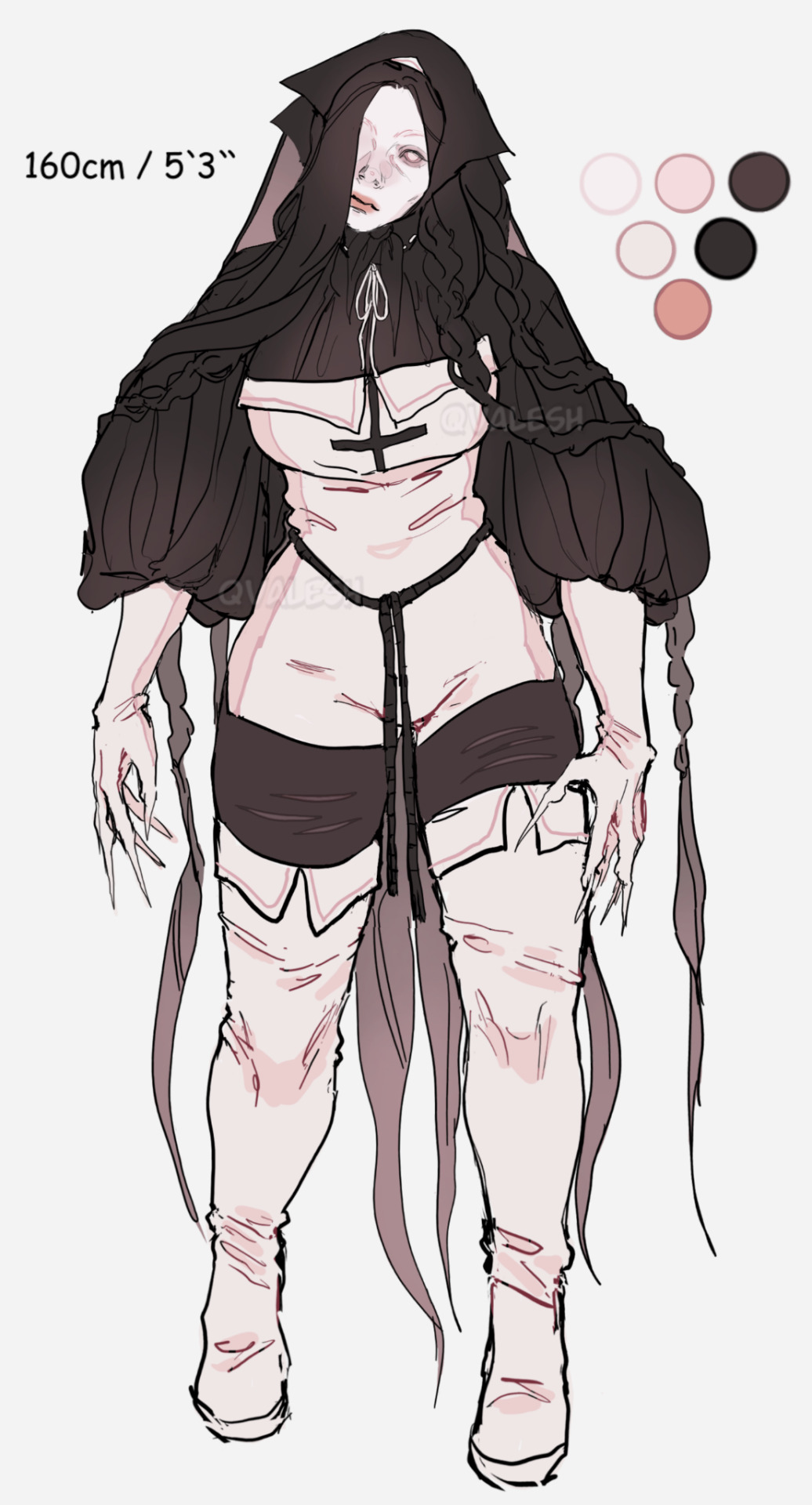

still cant give her a name, but thinking of Marpha

a little close up! love her
#art#digital#digital art#artwork#digital illustration#character art#character design#artist on tumblr#creepypasta#creepypasta oc#creepypasta fandom#creepypasta original character#original character#oc#oc art#oc ref sheet#oc reference#illustration#digital artwork
24 notes
·
View notes
Text
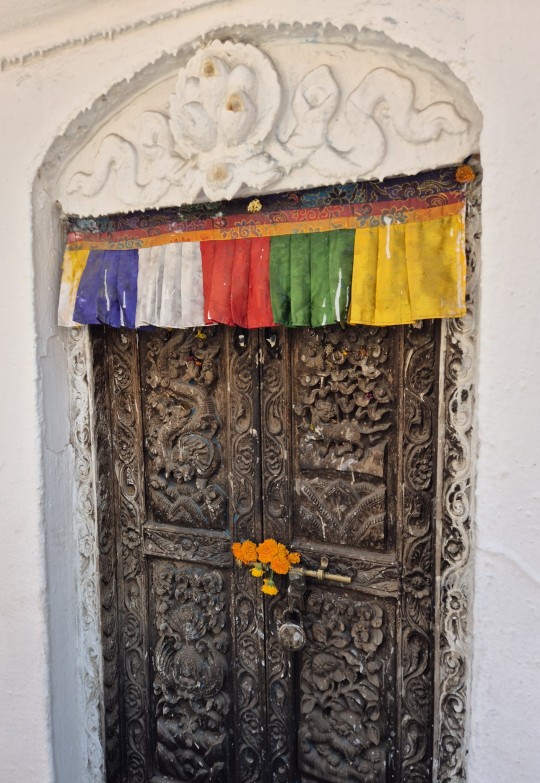
Reminds me of Marpha 🍎 !! :)
14 notes
·
View notes
Text


Léon Melchissèdec (1843-1925) and Speranza Engalli as, respectively, S.te Croix and Meala in Victor Massé's "Paul et Virginie". This is one of the very many photos made in the Atelier Nadar on the occasion of the creation of this title, at the Théâtre Lyrique in November 1876. Melchissèdec sang at the Paris Opéra from 1879 to 1891, and again from 1905 to 1912.
The Russian-born mezzo-soprano Speranza Engalli (b. 1848; d. ?) made her début in 1875 as Maddalena in Rigoletto, was to have a relatively short but brilliant career, later appearing at the Théâtre-Italien and the Opéra-Comique, as Carmen and as Eros in Psyché by Ambroise Thomas (1878), then at the Paris Opéra (Palais Garnier) as Amneris in Verdi’s Aida (1882). After her success as Marpha, she received high acclaim as the slave Méala in Victor Massé’s three-act opera Paul et Virginie (libretto by Michel Carré and Jules Barbier, based on the famous work of the same name by Bernardin de Saint-Pierre), when it was premièred at the Théâtre National Lyrique on 15 November 1876. Speranza Engalli appears among the musical personalities mentioned by Marcel Proust in À la recherche du temps perdu (Sodome et Gomorrhe).
#opera#classical music#music history#bel canto#composer#classical composer#aria#classical studies#Léon Melchissèdec#Melchissèdec#baritone#Paris Conservatoire#Opéra-Comique#Paris Opéra#classical musician#classical musicians#classical history#musician#musicians#chest voice#maestro#diva#prima donna#classical#historian of music#classical singing#classical singer#opera singer#Speranza Engalli#mezzo soprano
16 notes
·
View notes
Text

Corrin (F) Tiki Hilda Laslow Ephidel Farina Byleth (M) Frederick Maria
ARRIVAL [August 4th - August 10th]
Tag: #SVVerdane2023
Location: Nahan, Verdane [map of Jugdral] [map of Verdane]
From the day you arrived in Enbarr, through the following week aboard your ship bound for Jugdral, the weather had been pleasant. Clear skies, clear water, and most importantly, warm. But the dark clouds on the horizon had built up suddenly. So suddenly that your captain hardly had a chance to reroute. Powerless and simply hoping for the best, you watched as your ship drove straight into the storm. The decks flooded with rain and sea water. The vessel pitched and rocked across the churning waves. And you huddled together with your allies in the cabins, waiting. Suddenly, a call came that confirmed your worst fears: the ship is taking on too much water. Through relentless rain, you gathered your things and waited for instructions.
You don't know how long the storm lasted. Your memory and all of your belongings are in disarray. As soon as the storm began to let up, you were herded onto boats to take you to the nearest shore. And now you've finally landed. This is the fishing village of Nahan, in Verdane. Quite a distance from your original destination in Grannvale.
What you know:
Some of your allies are missing. Some of your allies are new. You assume you simply hadn't seen them earlier.
Keep in mind what your muses would ACTUALLY know about this part of Jugdral, whether from experience or from talking to allies prior to this mission.
The people of Nahan are, fortunately, quite hospitable. Or, at the very least, will not cast out a group that had clearly just escaped a sinking ship. They are wary of your weapons and armor, but have no reason to fear you when Marpha and its army is practically right next door.
The town itself seems to be rather wealthy, although it bears clear scars of war: the rubble of old buildings, houses still half-repaired, fences broken, and scorchmarks across the paved streets. Despite this, the docks are always bustling with fishermen, there's a bountiful bazaar along the central street, and logging companies settle on the northeastern edge of town. You're offered a couple of rooms at an inn (not great ones, but ones that you'd be a fool to turn down) free of charge for the first night, but that's the extent of the innkeep's generosity. You'll have to pay for additional days.
Not all of your things seem to have survived. Some of you are missing your weapons and belongings. Those of you who brought mounts still have your mounts though. Refer to this sheet for current inventories and gold. All spells must be cast with physical staves/tomes.
The villagers seem quite at ease with Corrin, Tiki, Hilda, Laslow, Alfred, and Maria.
They are wary of Frederick, Byleth, Farina, and Ephidel.
What to do (August 4th - 11:59PM EST August 6th):
Answer the question: Where do you go from here? Choices (Suggestions): Try to get help/info in the capital (Verdane), Try to get help/info in Marpha, Linger in Nahan for a while longer You must have your character's answer to this question by the end of this mini-segment on the 6th. They do not have to agree with anyone else on their team, so choose as your character would.
To better facilitate the conversational nature of this segment, this will be done as a chatplay similar to that offered to Team Guard during Keras Kai Elephas. A thread will be opened up in the Verdane team channel for characters to chat with each other in real time. This is completely optional, and characters can come and go as they wish. The setting is one of the two rooms given to your team at the inn.
If you wish to ask a nearby NPC some questions during the chatplay (for example, the innkeep, a random patron, or anyone else that comes up while talking to Mod Ree about the setting), you're more than welcome to. They'll engage with you as long as they're amenable to conversation.
When the chatplay is finished on the 7th, you all can choose how you want to move it to the dash: each of you can post a drabble summarizing your muse's involvement in the discussion, you can create a thread where you capture the gist of what happened, but don't necessarily copy the whole conversation word-for-word, or put it on the dash in any other way that you can think of
While the chatplay is happening, your muses are free to thread with each other about other aspects of their experience in Nahan. If you need additional information about the village, ask Mod Ree. Get creative! Now's your chance to explore.
What to do (August 7th - 10th):
After much deliberation and some investigation around Nahan, the entire group decides to embark for the capital, which lies northwest beyond the Spirit Forest. This means you will not be paying for an additional day at the inn.
It's now evening on the day of your arrival in Nahan. Your plan is to leave first thing in the morning, but in the meantime, make sure your supplies are in order. Do some last minute shopping, or some relaxing with your allies. This will be somewhat of a rest period so that you have time to move your chatplays to the dash in whichever forms you see fit. Your group will officially embark later in the week.
Feel free to start additional interactions with each other. These will be traditional threads.
3 notes
·
View notes
Text
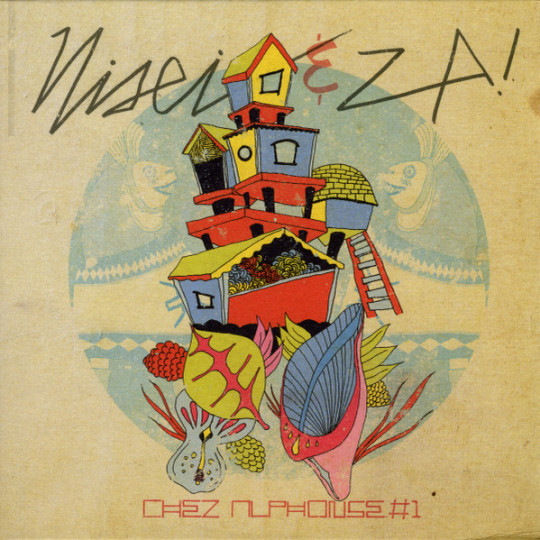

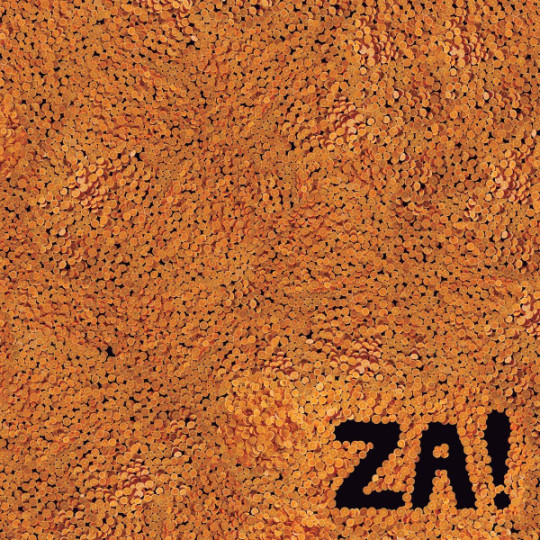


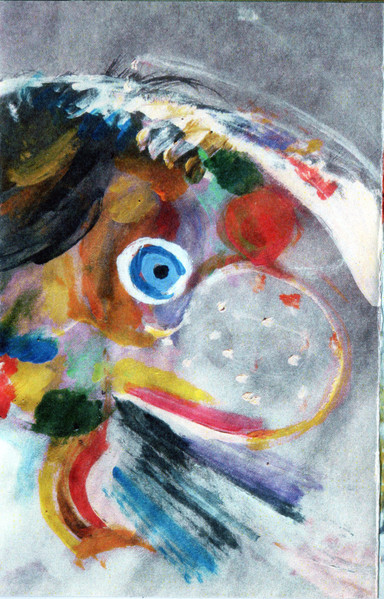

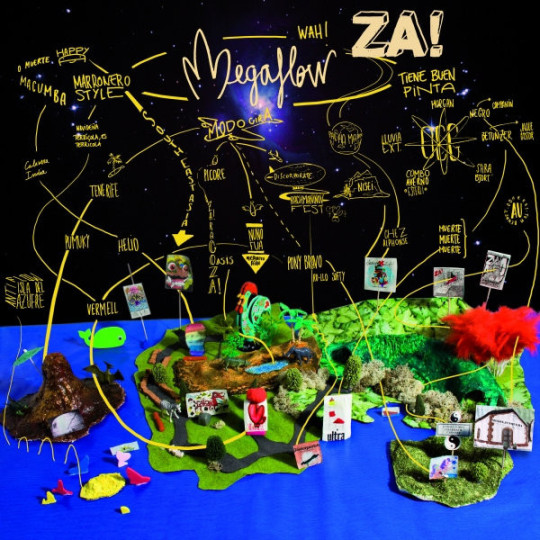
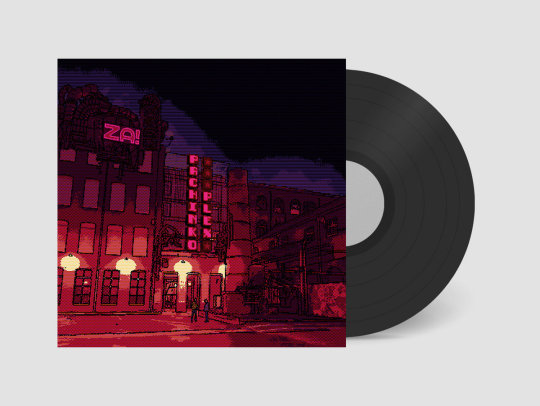
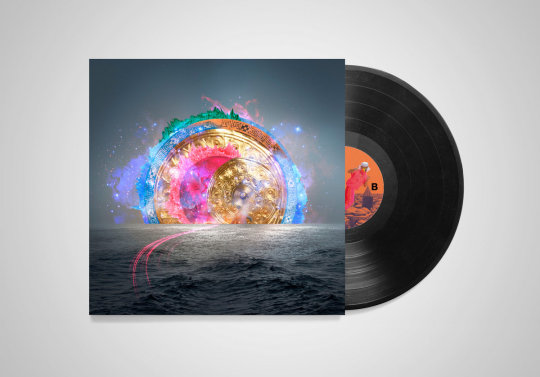
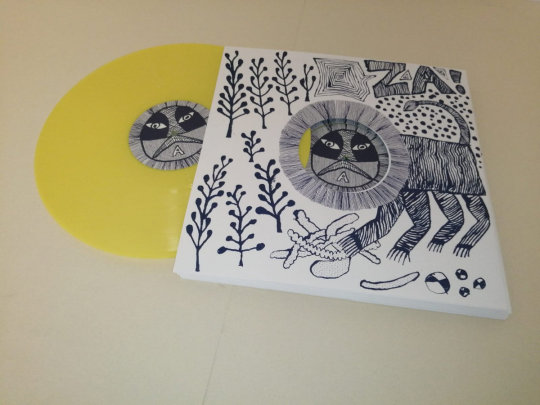
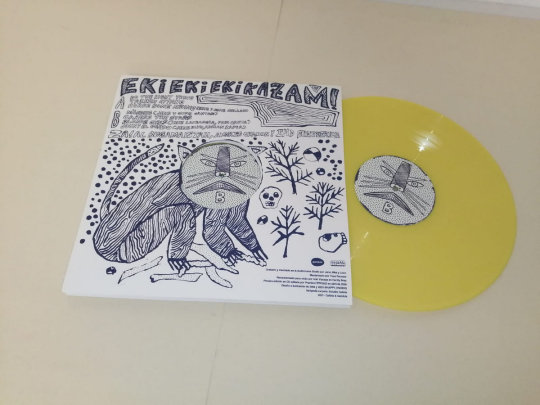
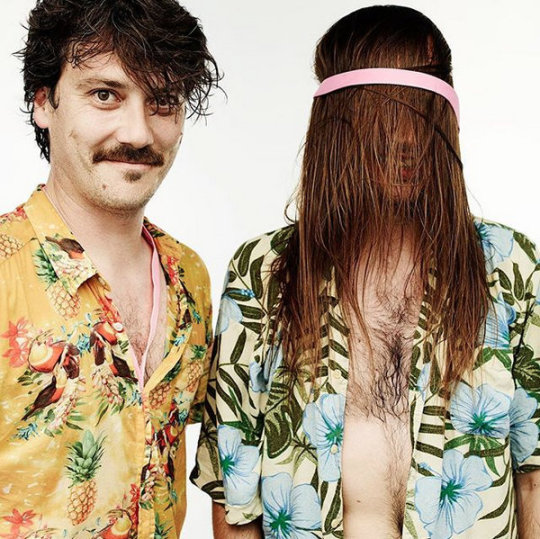

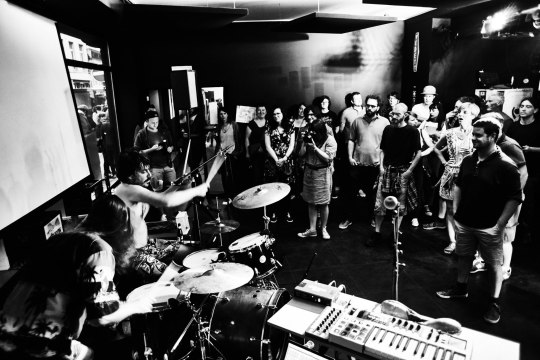

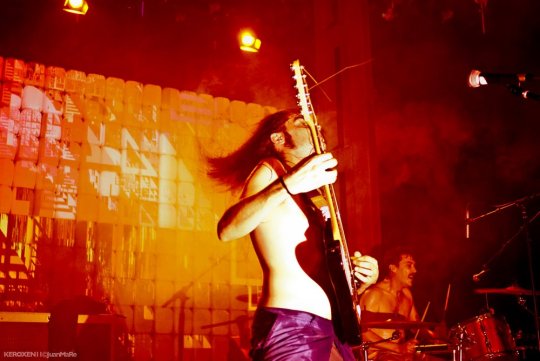
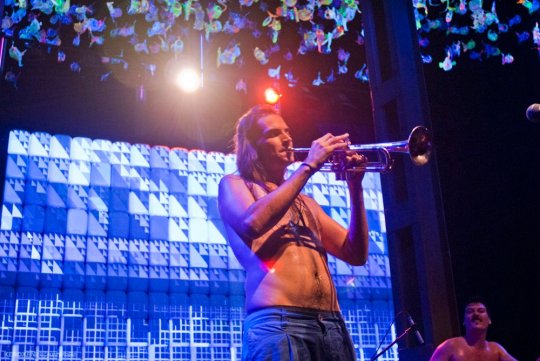
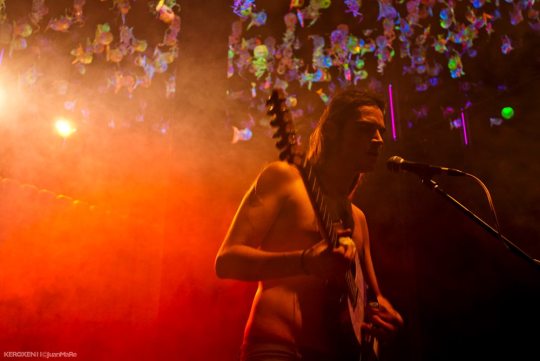
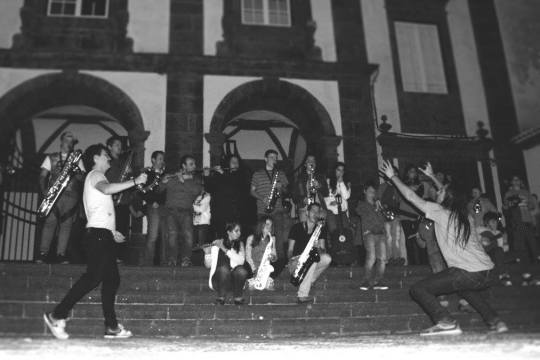

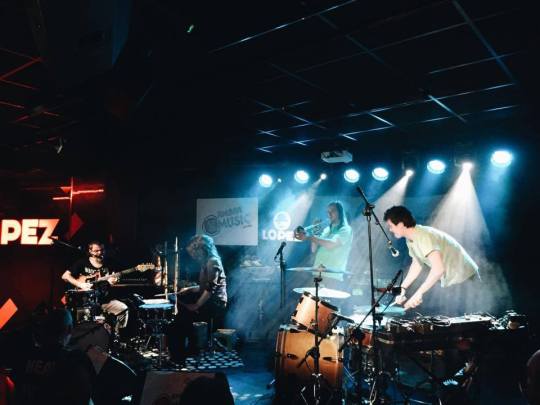
ZA! "Eki Eki Eki Kazam!" 2006 + "Macumba O Muerte" 2009 + Nisei & ZA! "Chez Alphonse #1" EP 2010 + "Megaflow" 2011 + "Wanananai" 2013 + "Jose's Ministry Of Sound" 2015 Cassette + "Loloismo" 2015 + "Pachinko Plex" 2018 + "ZA! & la TransMegaCobla" 2023 + Barcelona,Flamenco Experimental,Avant Garde,Noice,Punk,Free Jazz,Alternative,Drone,Math Rock,Electronic,Folk,Jazz Rock
full spotify
https://open.spotify.com/album/43UskBU6jj0D6AYZ9GiG0V
https://open.spotify.com/album/3e8QTCNgByJtDeFjuQOmhh
https://open.spotify.com/album/5RBw3uUvYgHlhzXcukTi7E
https://open.spotify.com/album/4XaEkjkLGwrlEZRIdGXvwo
https://open.spotify.com/album/3c40M3zgiDQihZJxl53jye
https://open.spotify.com/album/3sWnwxvobQKKANZ3TztS0f
https://open.spotify.com/album/1SxElOFAE51M4AtqmYRnKP
https://open.spotify.com/album/7IoB0jfa37QvDeeFEaQc3n
https://open.spotify.com/album/4IVIGFHTMxUHZK5669VTzQ
https://open.spotify.com/album/2u62C4T3wa1hGrdpdzqAxw
ZA! "Eki Eki Eki Kazam!" 2006
Tracklist Do The Right Thing 4:48 Takeshi Kitano 7:26 Horse Bone Riding 5:41 Möebius 3:31 Caress The Stars 4:14 Blonde Girls 5:19 Johny 7:27
ZA! "Macumba O Muerte" 2009
Tracklist Bugamaistah, Spazzfrica Ehd & Papa Dupau Vs Ceaucescu Doble Cobra La Cólera De Mister El Sopapo Indio (Rodrigo's Special) Debens Y Los Enigmas Del Hamma "You Win/Game Over/Credits/Staff" - Baches Mobutu#1: Kinshasa Beat Mobutu#2: Katanga Boma-Ye Buenos Corceles (Eki Attar) Polígamo Industrial Planta Carnívora Que Viene Hammurabi
Nisei & ZA! "Chez Alphonse #1" EP 2010
Tracklist A1 Nisei– Ens Trobàvem A Faltar Drums [Segona Bateria], Clarinet – Spazzfrika Ehd Performer [Nisei] – Alfons Serra, Cristian Pallejà, Edu Campos, Marc Balfagón Trumpet – Papa duPau* A2 Nisei– Des D'Aquesta Banda Drums [Segona Bateria], Clarinet – Spazzfrika Ehd Performer [Nisei] – Alfons Serra, Cristian Pallejà, Edu Campos, Marc Balfagón B1 Za!– Nouakchott Marimba, Maracas – Alfons Serra Performer [Obre I Tanca Una Porta] – Marc Balfagón Performer [Sacseja L'Ampolla D'Aigua] – Edu Campos Performer [Za!] – Papa duPau*, Spazzfrika Ehd
ZA! "Megaflow" 2011
Tracklist Calonge Terrassa, Kalon-Jah! Tewra-ssah! Nanavividedeñaña (Marronero Style Cover) PachaMadreTierraWah! #1 PachaMadreTierraWah! #2: Da Remix Mesoflow Megaflow #1 Megaflow #2: MegaSLOW Bomboklat #1: Da Gwelda Egli Bomboklat #2: In A Bomboklat Casamance Un: Voyage De Bugamaistah, De La Casamance À South East Asia Casamance Deux: Bugamaistah Prend La Conscience Mystique Du Gekko Casamance Trois: Spazzfrica Ehd Et Papadupau Se Communiquent Télépathicament Avec Bugamaistah Exaflow
ZA! "Wanananai" 2013
Tracklist Torrefacto Wagneriano Gacela Verde Gran Muralla China Chinaloop Súbeme El Monitor El Calentito #1 El Calentito #2 El Calentito #3 Mr. Reality Singapore Airlines Singaloop Hotto! Hottero!! Hottesto!!! Cha Cha Cha Tueste Natural
ZA! "Jose's Ministry Of Sound" 2015 Cassette
Tracklist 1 Badulaque (Furious Sessions) 2 Casamance Un (Furious Sessions) 3 Gacela Verde (Furious Sessions) 4 El Calentito 1 (Furious Sessions) 5 El Calentito 2 (Furious Sessions) 6 Heliogabal Mix 7 Help Me Instrumental 8 Cap a Paisatges Nous 9 Otra Vez Riccio Mix 10 Frecuencia Fantasma 11 Manolito
ZA! "Loloismo" 2015
Tracklist La Maquinaria Está Engrasada Badulake Empatando Mundo Estrella Sancha Hablas Como Autechre #1 Hablas Como Autechre #2 Loloismo Captain Rondo Don Autoleyendas ¡Aquí Huele A Assufre!
ZA! "Pachinko Plex" 2018
Tracklist Ochate Test D'Estrès Pachinko: Las Monedas Pachinko: Riff Madre Avances 1 2 3 Maningue Nais Solo Chezz Pachinko: Tramuntana
ZA! "ZA! & la TransMegaCobla" 2023
Tracklist 1 La sardana de Baal Hammon 2 El Medisabor de Le'an El Nim 3 El Sweep The Lehelan 4 La Gnaoua de Yishma Qala! 5 Ela Tho 6 El Gosse de Marpha 7 El Balearic de Qaa El Ril 8 La Kopanitza d'Aruj Yamim 9 Fandangos d'Aruj Yamim 10 El Djent d'Aruj Yamim Discography: “Eki eki eki Kazaam!” (2006, CD-R) “Macumba o Muerte” (2009, LP) “Chez Alphonse” w/Nisei (2011, 7”) “Megaflow” (2011, LP) “Wanananai” (2013, LP) “Loloismo” (2015, LP) “Jose’s Ministry of Sound” (2015, K7) “Pachinko Plex” (2018, LP) Split with La Jungle (2021, 7”)
ZA! "Eki Eki Eki Kazam!" 2006 + "Macumba O Muerte" 2009 + Nisei & ZA! "Chez Alphonse #1" EP 2010 + "Megaflow" 2011 + "Wanananai" 2013 + "Jose's Ministry Of Sound" 2015 Cassette + "Loloismo" 2015 + "Pachinko Plex" 2018 + "ZA! & la TransMegaCobla" 2023 + Barcelona,Flamenco Experimental,Avant Garde,Noice,Punk,Free Jazz,Alternative,Drone,Math Rock,Electronic,Folk,Jazz Rock
https://johnkatsmc5.blogspot.com/2025/06/za-eki-eki-eki-kazam-2006-macumba-o.html?view=flipcard
https://johnkatsmc5.tumblr.com/post/785877756878716928/za-eki-eki-eki-kazam-2006-macumba-o-muerte
#ZA! “Eki Eki Eki Kazam!”#ZA! “ZA! & la TransMegaCobla”#ZA! “Pachinko Plex”#ZA! “Loloismo”#ZA! “Jose's Ministry Of Sound”#ZA! “Wanananai”#ZA! “Megaflow”#1"#Nisei & ZA! “Chez Alphonse 1”#ZA! “Macumba O Muerte”#spain experimenral#spain avant garde#spain math rock#spai alternative rock#spain noise rock
0 notes
Text
Through the Himalayas on a Motorcycle: A Photo Journal

There’s something uniquely liberating about exploring the Himalayas on a motorcycle. The winding mountain roads, snow-capped peaks, quiet villages, and the ever-changing landscape create an experience that feels more like a dream than a journey.
In this blog, we’ll take you along a visual and narrative journey through Nepal’s Himalayan region — from the dusty roads of Lower Mustang to the serene heights of Manang. Whether you're a seasoned rider or someone dreaming of their first motorcycle tour, this photo journal captures the essence of what it's like to ride through the roof of the world.
The Road Begins: Kathmandu to Pokhara
Distance: 200 km Ride Time: 6–7 hours
Our journey starts in the lively city of Kathmandu, a hub of culture, traffic, and noise. As we leave the city behind, the road opens up to green hills, river valleys, and fresh mountain air. The ride to Pokhara sets the tone for the adventure ahead.
Highlights:
Morning coffee with a view of the Trishuli River
First sight of the Annapurna range on the horizon
Lakeside Pokhara's relaxed charm, perfect for pre-trip relaxation
Photo Moment: Rider silhouetted against the backdrop of Phewa Lake with the Annapurna range reflecting on the water.
Into the Wild: Pokhara to Jomsom (Lower Mustang)
Distance: 160 km Ride Time: 8–9 hours (due to off-road terrain)
From Pokhara, the road slowly transforms. Smooth highways give way to rocky trails and river crossings as we head north toward Jomsom, the gateway to Mustang. The change in terrain also signals a shift in landscape—from green to rugged, lush to barren.
Highlights:
Riding through Kali Gandaki Gorge, one of the deepest in the world
Crossing suspension bridges and stopping at roadside waterfalls
Windy afternoon rides as Mustang’s desert landscape comes into view
Photo Moment: Dust trail rising behind the bike as it climbs toward the village of Marpha, with whitewashed stone houses in the distance.
The Kingdom of Mustang: Jomsom to Lo Manthang
Distance: 80 km Ride Time: 6–7 hours
This leg of the trip is nothing short of magical. Lo Manthang, the ancient walled capital of Upper Mustang, feels untouched by time. The roads are demanding — steep, narrow, and often challenging — but the payoff is enormous.
Highlights:
Ancient caves carved into cliffs at Chhoser
Monasteries echoing with centuries-old chants
Riding through red-and-brown desert valleys surrounded by snow-capped peaks
Photo Moment: The golden light of sunset hitting Lo Manthang’s red cliffs as prayer flags flutter overhead.
Touching the Sky: Annapurna Circuit to Manang
Route: From Besisahar to Manang via off-road track Ride Time: 2–3 days with acclimatization
From Mustang, we loop back toward Manang, a jewel along the Annapurna Circuit. The road narrows into technical off-road trails surrounded by dense pine forests, glacial rivers, and towering mountains.
Highlights:
Climbing toward 3,500 meters above sea level
Passing yak herds and prayer walls
Resting at Gangapurna Lake, its icy-blue waters surrounded by snowy peaks
Photo Moment: Rider parked at the edge of the lake with Annapurna III in the background — a moment of silence in the middle of nowhere.
Culture and Connection: Villages and Locals
One of the most unforgettable aspects of motorbiking through the Himalayas is the people. In every village — from Tatopani to Kagbeni — you'll find warmth, smiles, and curiosity. The ride is tough, but the hospitality makes it easier.
Cultural Touchpoints:
Sharing butter tea with a local family in Muktinath
Watching kids wave as you pass by their village school
Visiting ancient monasteries and listening to the wisdom of Buddhist monks
Photo Moment: Close-up of wrinkled hands pouring tea, with a prayer wheel spinning in the background.
Behind the Scenes: The Motorcycle, the Gear, and the Grit
Motorcycling in the Himalayas is as much about the machine as it is about the mountains. Having the right gear can make or break the trip.
Recommended Motorcycles:
Royal Enfield Himalayan: Built for rugged terrain and high altitudes
Hero Xpulse 200: Lightweight and affordable
Honda CRF 250L: Excellent off-road capability
Essential Gear:
Waterproof riding jacket and pants
Thermals, gloves, and layered clothing
Spare tools, tubes, and a basic toolkit
First aid kit and altitude sickness tablets
Photo Moment: A dust-covered Royal Enfield parked at a roadside tea shop, panniers open, tools scattered — the reality behind the adventure.
Nature’s Drama: Weather and Landscape
The Himalayas don’t just change with every turn — they change with the hour. From sunny valleys to foggy mountain passes and the occasional snowfall, nature puts on a constant show.
Natural Wonders Along the Ride:
Rhododendron forests in spring
Rocky cliffs glowing orange at sunrise
Snowfall at high-altitude passes
Thunderclouds rolling in over wide plateaus
Photo Moment: A panoramic shot of the rider with arms open wide, standing on a hilltop under a dramatic Himalayan sky.
Tips for First-Time Riders in the Himalayas
If you’re thinking about planning your own motorcycle tour in Nepal, here are a few beginner-friendly tips to get you started:
Start slow: Choose a short route like the Kathmandu Valley ride if you're not used to long-distance biking.
Know your limits: High altitudes can affect your energy and focus. Don’t push too hard.
Pack wisely: Travel light but don’t forget warm clothes, tools, and snacks.
Ride responsibly: Respect local customs, drive slowly through villages, and avoid disturbing wildlife.
Use a guide: If you're unsure, consider booking with an experienced tour company like Nepal Moto Tours. They handle permits, routes, and mechanical support.
Conclusion
Riding through the Himalayas is more than a road trip — it’s a life-changing journey. Each turn brings you closer to nature, culture, and your own sense of adventure. You feel the cold air, hear the silence of the mountains, and see places most people only dream of.
For beginner riders, this isn’t just an ambitious goal — it’s a possible and incredibly rewarding one. With the right preparation, route, and mindset, the Himalayan motorcycle tour is one of the best experiences you'll ever have.
So, whether you're flipping through photos on your phone or planning your next adventure, remember that the road through the Himalayas is waiting — and it’s best explored on two wheels.
0 notes
Text
Upper Mustang Overland Tour
Upper Mustang: Overview
The Upper Mustang is one of the best travel destinations in Nepal. Mustang, one of Nepal’s 77 districts, is a naturally gifted place. Bordering Tibet, it is also known as the Land behind the Mountains. Once a kingdom, it is now part of Nepal and is open to tourists.
Mustang, which is also known as the “Forbidden Kingdom,” was closed off until 1992. However, currently, Mustang offers travelers a mix of culture, adventure, and natural beauty. Surrounded by snow-capped peaks to the east and west, the landscape creates an opening in between the mountains to enter Mustang.
Lo Manthang, the capital of Mustang, is a scenic village located at an elevation of 3840m. The Kora La Border is also close to Lo Manthang, which is another major attraction of the Upper Mustang region.
Upper Mustang Overland Tour
The Upper Mustang Overland Tour involves exploring remote places of this region in a 4WD jeep. This tour does not involve walking on foot; rather, you will be exploring most places in an off-road jeep.
Such vehicles are designed to tackle tough terrains and slippery roads and can easily cross off-road sections, which are pretty frequent in the Mustang region. A perfect overland tour to Mustang will ensure you explore most places in a relaxed way.
Major Attractions of This Overland Tour
Muktinath Temple: It is probably one of the most popular destinations in the Mustang Region. Also known as the gateway to Upper Mustang, it is famous for its beautiful views of Nilgiri, Dhaulagiri, and other snow-capped peaks. It also holds a religious significance.
Kagbeni: Kagbeni is a small village located on the banks of the Kali Gandaki River. Viewed from a distance, this place looks like a medieval town. It also serves as the entry point for entering the Upper Mustang region. The charm of Kagbeni lies in its old houses and ancient traditions that are still practiced by the locals here.
Marpha Village: The famous Marpha village is known to produce apple-themed products. You can also find the famous “Jerry Galli,” which is a famous street in this region where a movie was filmed.
Lo Manthang: Also known as the walled city, Lo Manthang is a beautiful village and the capital of Mustang. This walled city is a living museum, and its whitewashed houses make any first-timer fall in love with the place. It is one of the most important places in the Mustang district.
Chhoser Caves: Located close to Lo Manthang, these caves are believed to have formed over 2000 years ago. Locals believed they were used as houses, hiding spots, or meditation rooms. Very little is known about these caves, and they remain a mystery to this date.
Upper Mustang Overland Tour Facts
Location: Mustang and Upper Mustang
Distance: 450 km from Kathmandu
Trip Duration: 7 Days
Maximum Elevation: 3810 meters
Upper Mustang Overland Tour Itinerary for 2025
Day 1: Arrival in Kathmandu and Domestic Flight to Pokhara
On the first day of your tour, you will arrive in Kathmandu, and then you will take a flight to Pokhara via domestic airlines. The 30-minute flight is scenic, as you will spot numerous snow-capped peaks in the distance. Overnight in Pokhara.
Day 2: Flight to Jomsom and drive to Ghami
For the second day, you will fly from Pokhara to Jomsom, which has a domestic terminal. From Jomsom, your overland tour begins, as you will be traveling in a comfortable 4WD jeep. Your next destination for DAY 2 will be Ghami. Overnight in Ghami.
Day 3: Ghami to Lo Manthang
Although the distance from Ghami to Lo Manthang is a mere 30 kilometers, it will still take you hours to reach the walled city. Along the way, you will cross a high-altitude pass known as Tsarang La Pass. Once you reach Lo Manthang and take a rest, you can explore the streets.
Day 4: Exploration Day
On the fourth day, you will spend most of your time exploring the surroundings of Lo Manthang. The Tibetan-influenced cultures of Lo Manthang are pretty unique to people who are here for the first time. There are numerous religious sites, like monasteries and gompas, around Lo.
You can enjoy these days at a steady pace, exploring all the places around Lo Manthang. Namgyal Monastery is also located at a short distance from Lo Manthang, which you can pay a visit to.
Day 5: Lo Manthang to Muktinath and Jomsom
On the fifth day, your return journey begins. You will descend towards Kagbeni from Upper Mustang. The road is mostly a series of off-road and paved roads up to Kagbeni.
From Kagbeni, we will ascend towards Muktinath, 3800 meters. From Muktinath Temple, you will get mesmerizing views of the snow-capped peaks like Nilgiri, Tukuche, and the majestic Dhaulagiri.
After exploring Muktinath, we will be descending back to Jomsom.
Day 6: Flight to Pokhara
From Jomsom, take a flight to Pokhara, the tourist capital of Nepal, home to numerous attractions. After you land, you can enjoy the beautiful Lakeside of Pokhara for an evening stroll.
Day 7: Flight or Drive from Pokhara to Kathmandu
If you’d like a more laid-back experience, you can take a flight from Pokharato Kathmandu. If not, Pokhara is around 200 km from Kathmandu, so you can drive back as well.
Best Seasons To Visit Upper Mustang
Regardless of the destination, most of the places in Nepal are best visited during Spring and Autumn. However, Mustang is a region that receives very little rainfall, so you can even visit this place during the Monsoon.
Still, spring and autumn are the best times to see this place. Snowcapped peaks are easily visible during these months. Avoid the monsoon season, as the temperatures drop significantly.
For More Details, Click Here
0 notes
Text
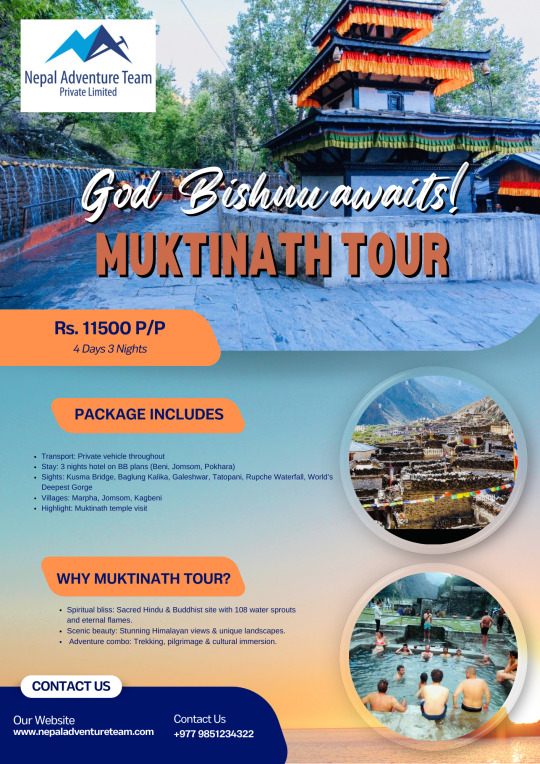
Muktinath Tour Package for Nepalese Tourists (3 Nights / 4 Days)
Highlights of the Tour
✔ Scenic drive from Kathmandu to Pokhara
✔ Visit the famous Phewa Lake in Pokhara
✔ Explore Kusma Bridge, Galeshwor Temple, Rupse Waterfall, and the world’s deepest gorge
✔ Experience the unique apple village of Marpha
✔ Pilgrimage to Muktinath Temple (one of the 108 Divya Desams)
✔ Relax in the natural Tatopani Hot Spring
✔ Half-day sightseeing in Pokhara before returning to Kathmandu
Detailed Itinerary
Day 1: Kathmandu → Pokhara (8-9 hours drive)
- Early morning departure from Kathmandu in a comfortable EV Van with AC.
- Enjoy the scenic drive along the Prithvi Highway with views of rivers, hills, and villages.
- Arrive in Pokhara, check into the hotel (BB Plan).
- Evening leisure time at **Phewa Lake** (optional boat ride).
- Overnight stay in Pokhara.
Day 2: Pokhara → Jomsom (via Mustang Route)
- Early morning drive towards Jomsom via Beni**.
- Stop at Kusma Bridge (one of the tallest suspension bridges in Nepal).
- Visit Galeshwor Temple, a sacred Shiva temple.
- Explore Rupse Waterfall and the world’s deepest gorge (Kali Gandaki Gorge).
- Drive through Marpha, famous for its apples and traditional Thakali culture.
- Reach Jomsom, check into the hotel (BB Plan).
Day 3: Jomsom → Muktinath → Tatopani → Pokhara
- Early morning drive to Muktinath Temple (3,710m).
- Perform prayers and rituals at the sacred temple (known for 108 water sprouts & eternal flame).
- Drive back to Pokhara via Tatopani, where you can enjoy a relaxing natural hot spring bath.
- Arrive in Pokhara in the evening, check into the hotel (BB Plan).
Day 4: Pokhara Sightseeing → Kathmandu
- Half-day sightseeing in Pokhara (visit Davis Falls, Gupteshwor Cave, or Peace Stupa).
- Afternoon drive back to Kathmandu.
- Tour concludes with drop-off at your location.
Trip Cost Includes
✅ All transportation in a private EV Van with AC (Kathmandu-Pokhara-Jomsom-Muktinath-Pokhara-Kathmandu)
✅ 3 nights hotel accommodation on BB Plan (Bed & Breakfast)
✅ Sightseeing as per the itinerary (including entrance fees)
✅ Parking fees & local taxes
✅ All government VAT and taxes
Exclusions
❌ Lunch & dinner (except breakfast)
❌ Personal expenses (drinks, tips, etc.)
❌ Horse ride in Muktinath (optional)
❌ Any extra activities not mentioned in the itinerary
Why Choose This Package?
✔ Perfect blend of pilgrimage & adventure
✔ Comfortable & eco-friendly EV Van transportation
✔ Explore hidden gems like Marpha & Tatopani
✔ Budget-friendly for Nepalese tourists
Book Now & Experience the Divine Journey to Muktinath!🚗⛰️🛕
For booking & inquiries:
📞 +977 9851234322
🌐 www.nepaladventureteam.com
0 notes
Text
Nestled in the heart of Nepal’s mystical Mustang region, Shinta Mani Mustang is more than a hotel—it’s a gateway to a world where ancient traditions, dramatic landscapes, and visionary design converge. Designed by the legendary hotel architect Bill Bensley and operated in collaboration with Sherpa Hospitality, this all-inclusive retreat offers travelers an unparalleled journey into the soul of the Himalayas. From its awe-inspiring setting to its commitment to cultural preservation, here’s why Shinta Mani Mustang is redefining luxury travel in one of the planet’s most remote and spiritually charged destinations.

The Forbidden Kingdom Unveiled: Mustang’s Mystique A Land Frozen in Time Mustang, often dubbed the “Forbidden Kingdom,” remained closed to outsiders until the 1990s, preserving its Tibetan Buddhist traditions and stark, otherworldly landscapes. Perched on the edge of the Tibetan Plateau, this high-altitude desert is framed by the Annapurna and Dhaulagiri mountain ranges, with the Kali Gandaki River carving through its dramatic gorges 11. The region’s isolation has safeguarded its medieval villages, vibrant monasteries, and nomadic cultures, making it a living museum of Himalayan heritage.
Lower vs. Upper Mustang While Upper Mustang captivates with its arid, Mars-like terrain and the ancient walled city of Lo Manthang, Lower Mustang—home to Shinta Mani Mustang—boasts lush valleys, apple orchards, and snow-capped peaks like the 7,000-meter Nilgiri Mountain, visible from the resort’s floor-to-ceiling windows 116. The area’s unique geography, shaped by its position in the monsoon rain shadow, creates a surreal blend of alpine forests, desert cliffs, and turquoise glacial lakes like Dhumba, revered by Buddhists 11.

Bill Bensley’s Himalayan Masterpiece: Design Meets Tradition A Sanctuary Rooted in Local Culture Bill Bensley, celebrated for his whimsical and sustainable designs, has infused Shinta Mani Mustang with a deep respect for Mustang’s heritage. The resort’s stone-and-wood architecture mirrors traditional Thakali styles, using locally sourced materials such as Baglung stone and timber 9. Inside, yak-hair stools, handwoven Tibetan rugs, and thangka-inspired draperies pay homage to Tibetan Buddhism, while Hermès-felt bedspreads and Himalayan pink salt-lined bathtubs add a touch of modern luxury 69.
Art as a Window to the Soul The hotel doubles as an art gallery, showcasing works by American painter Robert Powell and Nepali artist Dhwoj Gurung. Each piece reflects Mustang’s landscapes and spiritual essence, from murals of the Kali Gandaki Valley to symbolic cloud motifs reminiscent of thangka scrolls 59. Even the minibar doors, crafted from conch shells, whisper of the region’s sacred symbology
3. Curated Experiences: Where Adventure Meets Enlightenment Cultural Immersion Shinta Mani Mustang’s five-night all-inclusive program is a tapestry of curated adventures:
Village Life & Spiritual Journeys: Explore 800-year-old Bon Buddhist villages like Lubra, where pre-Buddhist rituals endure, or witness monks chanting at Syang’s gompa 110. Participate in festivals like Tiji, where masked dances drive away evil spirits, or Yarthung, celebrating Mustang’s equestrian heritage
11. Pilgrimage to Muktinath: Bathe in the 108 sacred fountains of Mukti Dhara, a Hindu-Buddhist pilgrimage site believed to cleanse sins
5. Culinary Connections: Share meals with locals, such as Thakkali thali in Marpha, a village famed for its apple brandy and orchards 611.
Adventure in the Wild Trekking & Mountain Biking: Traverse trails offering vistas of Nilgiri and Tukuche peaks, or bike through Kagbeni’s terraced fields 110.

Helicopter Expeditions: Soar above Annapurna and Dhaulagiri for a bird’s-eye view of Mustang’s desert cliffs and ancient rock formations 111.
Horseback Riding: Ride sturdy Mustang ponies along historic trade routes, retracing the steps of Himalayan nomads 15.
Wellness for Body and Soul At the SoRig Spa, 11th-generation Amchi (Tibetan doctor) Tsewang Gyurme Gurung tailors therapies using Himalayan herbs and Sowa Rigpa practices. Post-trek, unwind with cupping massages, yoga sessions, or meditation led by Buddhist monks 36.
Sustainability and Community: Travel with Purpose Empowering Local Communities Half of Shinta Mani’s staff are women from nearby villages, and ingredients like yogurt and apples are sourced from local farms 69. The hotel partners with the Pasang Lhamu Foundation, supporting education for Nepali women and preserving cultural heritage 6.

Eco-Conscious Design The resort employs passive solar heating, insulated walls, and bioswales to minimize its environmental footprint. Even the stone construction blends seamlessly into the mountainside, honoring Mustang’s aesthetic 511.
A Culinary Odyssey: Flavors of the Himalayas Chef Krishna Subedi elevates local ingredients—think yak meat, wild mushrooms, and timur pepper—into gourmet feasts. Dine on beetroot momos (dumplings) under the stars, enjoy apple crumble picnics by glacial lakes, or sip a Kali Gandaki cocktail (whisky, plum wine, and dark beer) at the Aara Bar 69.

Practical Guide: Planning Your Journey Best Time to Visit March–May: Blooming rhododendrons and clear skies 11.
September–November: Festivals and crisp autumn vistas 11. Avoid July–August monsoons. Getting There Fly to Kathmandu, then take a scenic (but bumpy) 6-hour jeep ride or charter a helicopter to Jomsom. The journey itself—past prayer flags, waterfalls, and Tibetan chortens—is an adventure 106.
Why Stay Here? Shinta Mani Mustang isn’t just a hotel; it’s a portal to a vanishing world. With rates starting at $1,800/night (all-inclusive), it’s an investment in transformative travel—where luxury meets legacy, and every moment deepens your connection to the Himalayas 10.
Conclusion: The Call of the Mountains Shinta Mani Mustang is more than a destination—it’s a pilgrimage for the soul. Whether you’re meditating in a Bon monastery, trekking beneath Nilgiri’s snows, or simply soaking in a salt-lined tub while the Himalayas glow at dusk, this sanctuary invites you to shed the noise of modern life and embrace the timeless rhythm of Mustang. As Bill Bensley’s masterpiece proves, true luxury lies not in excess, but in authenticity—and there’s no place on Earth quite like this.
Ready to answer the call? Explore Shinta Mani Mustang’s curated journeys and let the Himalayas rewrite your story. Shinta Mani Mustang, Himalayan luxury travel, Bill Bensley design, Nepal cultural tours, Mustang trekking, Tibetan wellness retreats, sustainable hotels Nepal, all-inclusive Himalayan adventures.
0 notes
Text
Annapurna Circuit Trek: A Classic Himalayan Adventure

The Annapurna Circuit Trek is one of Nepal’s most iconic trekking routes, offering a perfect blend of stunning landscapes, diverse cultures, and high-altitude adventure. This trek takes you through lush valleys, remote villages, and across the famous Thorong La Pass (5,416m), providing breathtaking views of the Annapurna and Dhaulagiri ranges.
The Journey Begins
The trek usually starts from Besisahar, following the Marsyangdi River through subtropical forests and terraced farmlands. The trail gradually ascends, passing through villages like Chame and Pisang, where Tibetan-influenced architecture and Buddhist monasteries create a unique cultural atmosphere. The changing scenery, from green hills to rugged cliffs, keeps every day of the journey exciting.
Exploring Local Culture
One of the highlights of the Annapurna Circuit is the chance to experience the culture of the Gurung, Thakali, and Manangi people. As you reach Manang, a beautiful Himalayan village surrounded by towering peaks, you can explore monasteries, interact with the locals, and learn about their traditional lifestyle. The acclimatization day in Manang is essential, offering side trips to stunning viewpoints like Ice Lake or the Gangapurna Glacier.
Conquering Thorong La Pass
The biggest challenge of the trek is crossing Thorong La Pass (5,416m), the highest point of the journey. The climb is demanding, especially due to the altitude, but the reward is a breathtaking view of the snow-covered Himalayas stretching endlessly in all directions. The descent leads to Muktinath, a sacred pilgrimage site for both Hindus and Buddhists, known for its eternal flame and ancient temples.
A Change in Landscape
After Muktinath, the trail enters the arid landscapes of Lower Mustang, resembling the Tibetan Plateau. The journey continues through charming villages like Marpha, famous for its apple orchards, and Jomsom, where strong winds sweep through the Kali Gandaki Valley. Some trekkers end their journey here, while others continue towards Tatopani for a well-deserved dip in natural hot springs.
A Trek to Remember
The Annapurna Circuit Trek is a perfect mix of adventure, cultural exploration, and natural beauty. From lush green forests to snow-covered mountain passes and the barren landscapes of Mustang, this trek offers something new at every turn. The diverse scenery, warm hospitality, and rewarding challenges make it one of the best trekking experiences in Nepal. Whether you’re an experienced trekker or an adventure enthusiast, the Annapurna Circuit is a journey that stays with you forever.
0 notes
Text
安娜普納大環線,Jomsom
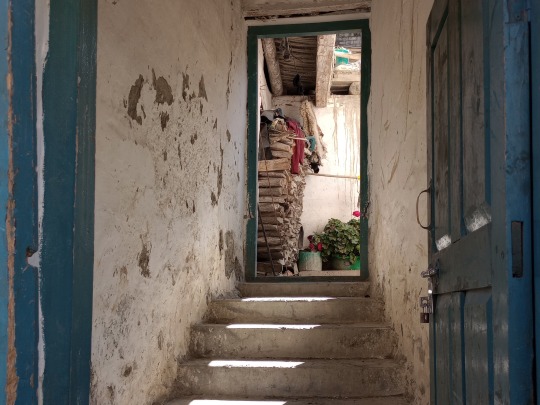
不死心前兩週止步於Manang,我決定從沒翻過去的Throng La Pass 隘口另一側的Jomsom再繼續。
於是從波卡拉直接搭小飛機上Jomsom,除了不想再顛簸一次十小時的山路,另外還想說搭小飛機順便從天空的角度看看那群雪山,結果沒想到小飛機飛得並不高,八千米的山頭都還在我們上方。
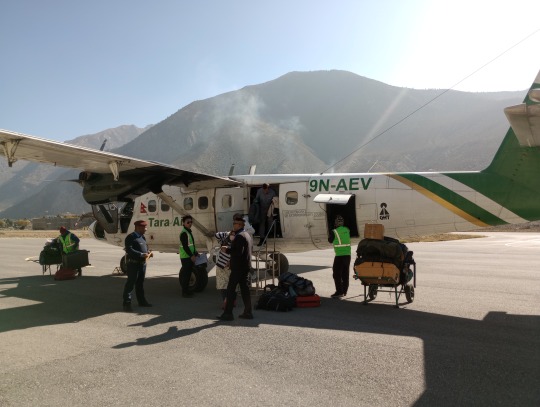

因為河谷下午會刮大風,所以小飛機都只能早上飛,而且還要看氣候狀況,我原本表訂七點的飛機,九點半多才起飛,不過半小時就抵達海拔2700米的Jomsom了。
一出機場就可以感覺氣溫比山下低好幾度,趕緊把外套穿起來。出了機場市區街道整潔的呢!新式的飯店和餐館林立在鋪好的大馬路兩旁。

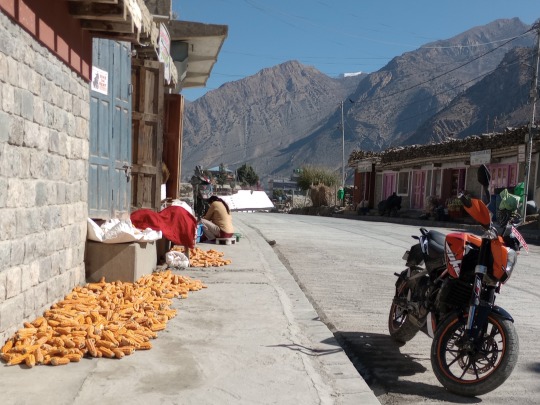

但我還是想去有著石板路的老市區,準備跟之前一樣,落腳在民家裡。結果沒想到這裡沒有吃飯就免住宿費這回事,繞了一圈才好不容易決定住哪裡。
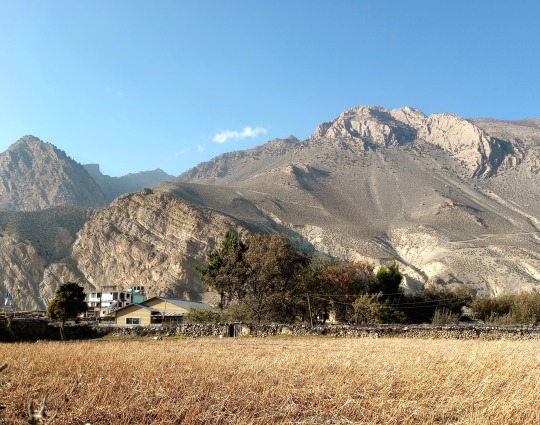

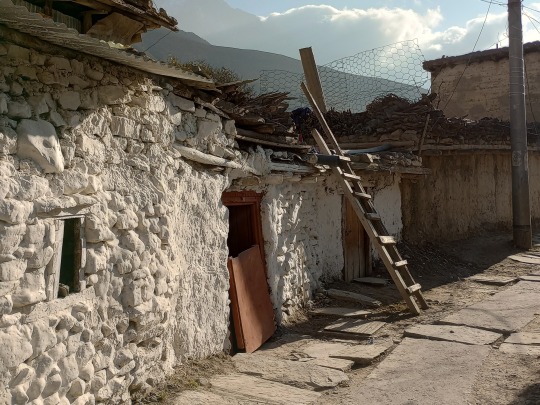
休息了一會才去ACAP check point報到,果然下午的風變好大,而且比我前兩週在另一頭的山上還冷啊!


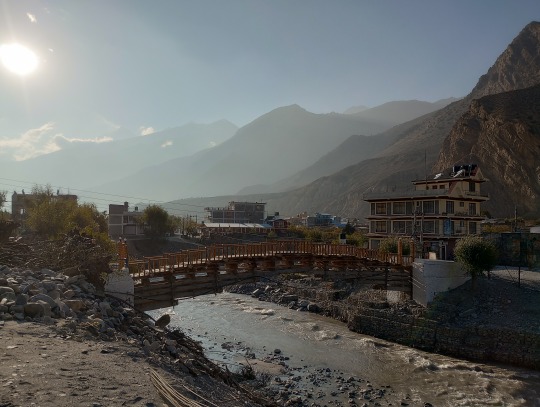
住宿:Hotel Snow Leopard,房間400rs/晚
費用:晚餐 (dal bhat) 350rs,早餐 (museli+masala tea) 300rs
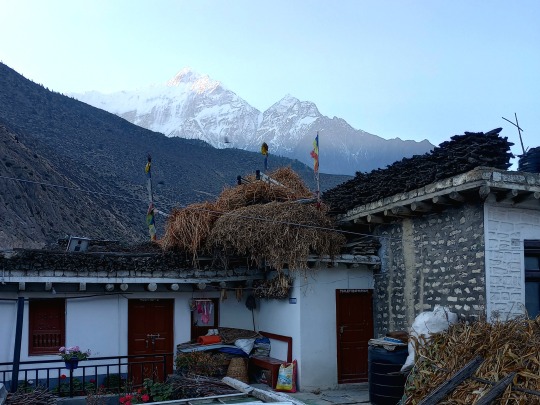
隔天決定在Jomsom多留一天,反正這次是從高海拔往下走,心理上沒有壓力,想多走走多享受一下山裡的生活,就打算去Jomsom後方的Thini村做一個簡單的一日健行。
沿著河谷裡的一大片梯田往上,正好可以看河谷對岸的機場和新市區。


進了Thini村莊看到人們都在為冬天來臨做準備,在屋頂上盡可能堆滿要用來生火的木材、要給牲畜的稻草糧食,同時還曬玉米和各種蔬菜。
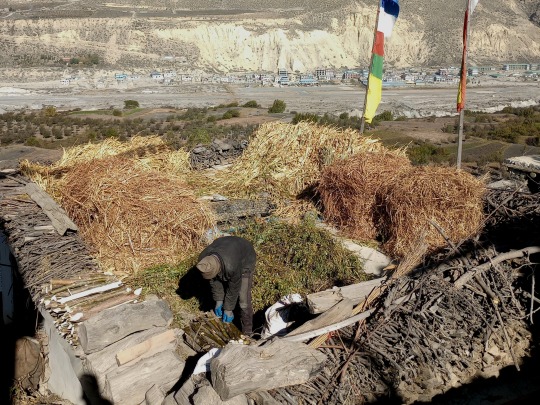
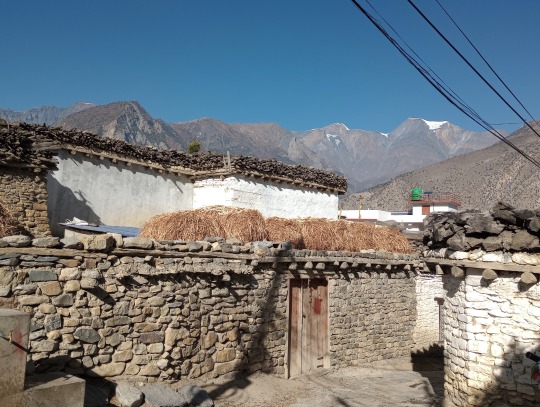
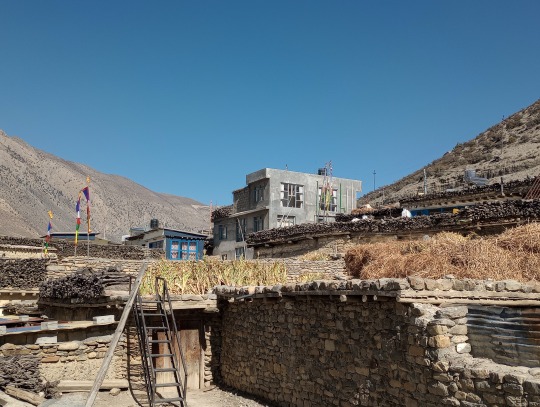
村子還保持著傳統的農作生活,中心有一個排球場,和一座佛教寺廟。後面山坡壁上有一個雪豹洞穴,可以一眼看盡整個村子和遠方河谷中的Jomsom。
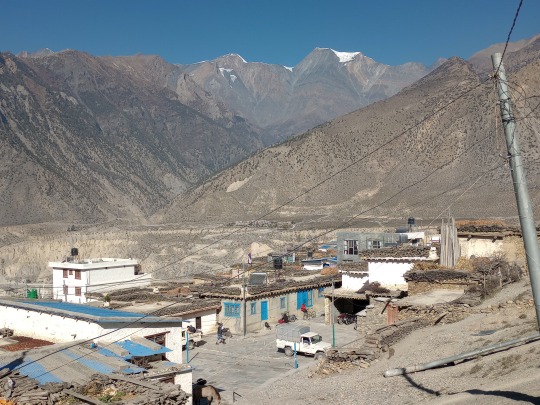
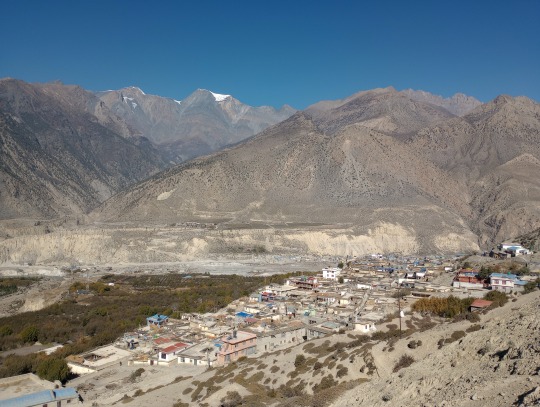
過了村莊還可以繼續走,先下一個河谷,過吊橋爬上一個小山頭,有一個堡壘遺址,更遠的另一個山頭則是藏傳佛寺Kutsab Terenga,夾在兩個山頭間有一個Dumba Lake,然後從這裡甚至要走去Marpha也可以。
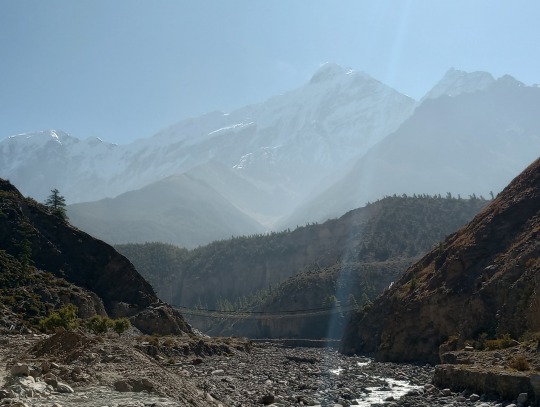
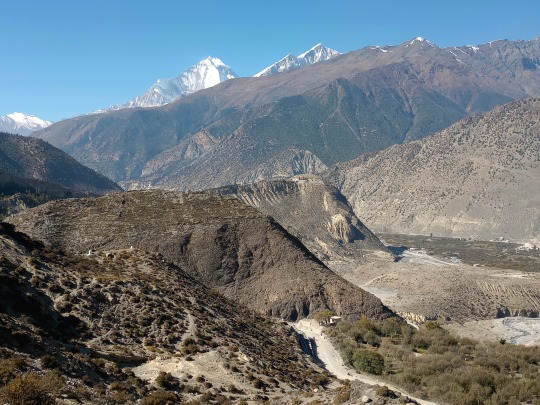
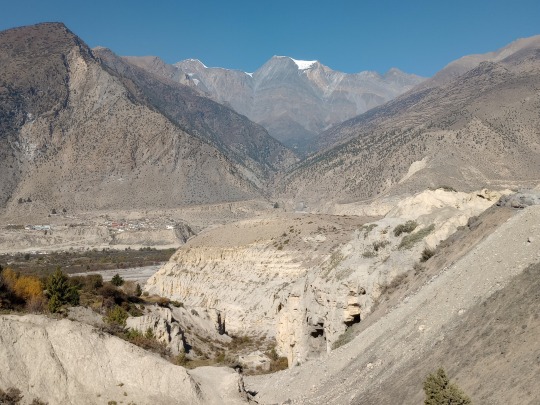
Dumba Lake 外國人門票50盧比。

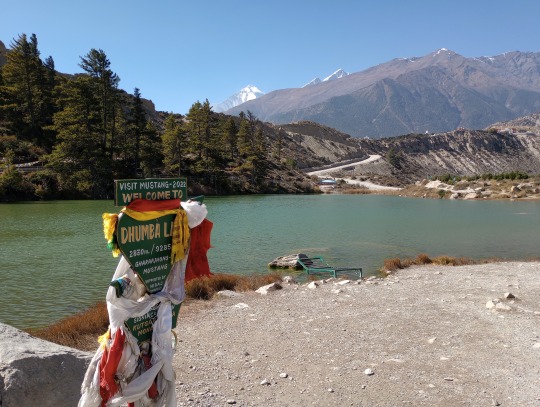
回程我特意穿過那一片梯田回Jomsom,想看看他們種些什麼,又再忙些什麼。
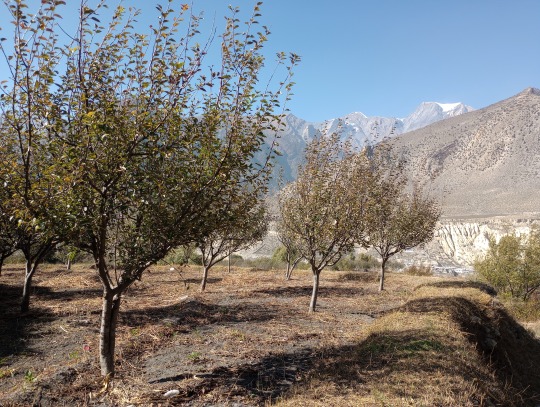
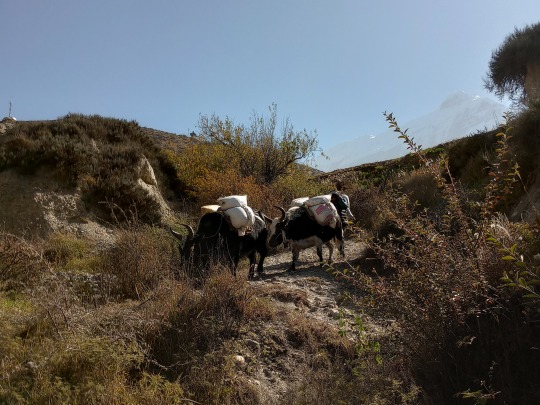


住宿:Hotel Snow Leopard,房間400rs/晚
費用:午餐 (veg tunkpa) 250rs + 茶 (masala tea) 80rs + 晚餐 (dal bhat) 350rs,早餐 (museli+masala tea) 300rs

0 notes
Text
Discover Mustang's Marpha and the Iconic Annapurna Base Camp Trek
Nepal, a paradise for trekkers, offers countless adventures, each unique in its landscape, culture, and charm. Among its treasures are Mustang's Marpha Village, renowned for its serene beauty and apple orchards, and the Annapurna Base Camp (ABC) Trek, an iconic journey to the heart of the Himalayas. Whether you're drawn to cultural exploration or high-altitude trekking, these destinations promise unforgettable experiences.
Why Visit Marpha, the Jewel of Mustang?
Nestled in the Mustang region of Nepal, Marpha is a picturesque village with a rich cultural heritage. Known as the Apple Capital of Nepal, Marpha is famed for its:
Apple Orchards and Delights: Taste the finest apple cider, dried apples, and Marpha’s legendary apple brandy.
Traditional Thakali Culture: Walk through cobblestone streets lined with whitewashed houses and immerse yourself in the warmth of the Thakali people.
Breathtaking Scenery: Surrounded by arid landscapes and towering peaks, Marpha offers a unique blend of natural beauty and tranquility.
Gateway to the Mustang Region: Perfect for exploring the mystical landscapes of Upper Mustang.
Highlights
Stroll through the village and visit the Marpha Monastery.
Enjoy the local cuisine, especially the Thakali meal paired with Marpha’s apple delicacies.
Capture stunning views of Nilgiri Peak.
Annapurna Base Camp Trek: The Crown Jewel of Himalayan Trekking
For trekkers seeking adventure, the Annapurna Base Camp Trek is a bucket-list journey. Starting from the lush foothills, the trek leads you to the majestic Annapurna Base Camp at an altitude of 4,130 meters.
Key Features
Diverse Landscapes: Traverse through dense forests, terraced fields, quaint villages, and alpine meadows.
Breathtaking Mountain Views: Witness panoramic vistas of Annapurna I, Machapuchare (Fishtail), and Hiunchuli.
Rich Cultural Experiences: Interact with the Gurung and Magar communities in villages like Ghandruk and Chhomrong.
Natural Hot Springs: Relax in the Jhinu Danda Hot Springs, a rewarding treat after long days of trekking.
Why These Destinations Complement Each Other
Combining the cultural charm of Marpha with the adventurous spirit of the Annapurna Base Camp Trek creates a unique travel experience. Start your journey by immersing yourself in the rich heritage of Mustang and then transition to the challenging yet rewarding trails of the Annapurna region.
Tips for Planning Your Adventure
Best Time to Visit:
Marpha: September to November or March to May for pleasant weather.
Annapurna Base Camp Trek: October-November and March-April for clear skies and moderate temperatures.
Permits: Secure the Annapurna Conservation Area Permit (ACAP) and TIMS card for the Annapurna region.
Guides and Porters: Consider hiring local guides or porters to enhance your experience and support the local economy.
Travel Insurance: Ensure your insurance covers trekking and high-altitude evacuation.
Conclusion
Whether you’re savoring apple treats in the peaceful lanes of Marpha or trekking to the awe-inspiring Annapurna Base Camp, these destinations showcase Nepal’s unmatched diversity. Each offers a blend of natural beauty, cultural richness, and unforgettable memories.
Plan your trip now and experience the magic of Mustang and Annapurna!
#mountains#nepal#trekkinginannpurna#culture#whoa#everest#travel#traveling#travel photography#tourism#reputation tour#photography#popularcultures#popular posts#himalayas#camping#hiking#road trip
0 notes
Text
How to Extend Your Annapurna Circuit Trek: Exploring Off-the-Beaten-Path Routes
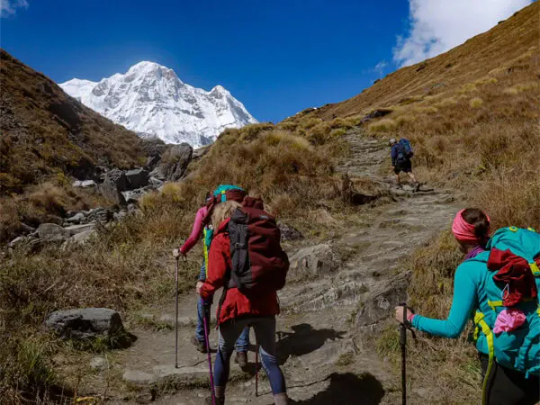
The annapurna circuit trek tour is a mesmerizing adventure, offering breathtaking landscapes, cultural immersion, and challenging trails. While the standard route is trendy, the trek has hidden gems to be explored. For those with an adventurous spirit, venturing off the beaten path can add unique experiences and unforgettable memories. Here's how you can extend your trek and explore some lesser-known routes.
Why Extend Your Annapurna Circuit Trek Tour?
The Annapurna Circuit is already considered one of the most iconic trekking routes in the world, but there's so much beyond the standard trails. Extending your trek allows you to:
Discover secluded villages and authentic cultural experiences.
Avoid crowded paths and enjoy solitude amidst nature.
Witness untouched landscapes, pristine rivers, and hidden waterfalls.
Challenge yourself with new terrains that offer rewarding views.
If you're ready to make your trek a little longer and much more exciting, here's where you should go.
Tilicho Lake: A High-Altitude Gem
Distance and Difficulty: Moderate to challenging; adds 3-4 days.
Tilicho Lake, the world's highest-altitude lake, is a must-visit extension of the Annapurna Circuit. Located at 4,919 meters, this stunning turquoise lake is surrounded by snow-capped peaks and offers serenity. The trek to Tilicho Lake requires acclimatization and some perseverance, but the sight of this pristine water body is worth every step.
Nar and Phu Valleys: Hidden Himalayan Treasures
Distance and Difficulty: Challenging; add 5-7 days.
The Nar and Phu Valleys are ideal for trekkers seeking authentic Himalayan culture and remote trails. These ancient villages are tucked away in the north, providing an unparalleled glimpse into Tibetan-influenced traditions. The journey involves crossing high-altitude passes and walking through rugged landscapes, but the warm hospitality of the locals makes it a rewarding detour.
Khopra Ridge: A Panoramic Paradise
Distance and Difficulty: Moderate; adds 4-5 days.
Khopra Ridge is a lesser-known alternative to Poon Hill and offers equally stunning panoramic views of the Annapurna and Dhaulagiri ranges. This extension is perfect for trekkers who love ridge walks and want to experience a mix of dense forests, open meadows, and rustic villages. The sunrise from Khopra Ridge is one of the most magical moments you'll witness.
The Ice Lake: A Tranquil Oasis
Distance and Difficulty: Moderate; adds 1-2 days.
Located near Manang, the Ice Lake (Kicho Tal) is a fantastic day hike for those who want a quick extension to their trek. Sitting at 4,620 meters, the lake offers sweeping views of the Annapurna range and a peaceful ambience. It's an excellent way to acclimatize and enjoy a quiet retreat.
Teri La Pass: A Remote and Adventurous Trail
Distance and Difficulty: Very challenging; adds 6-8 days.
For seasoned trekkers, the Teri La Pass is an exhilarating route that connects the Annapurna region to Upper Mustang. This high-altitude pass, located at over 5,500 meters, tests your limits but rewards you with dramatic landscapes and an unmatched sense of achievement. It's essential to have an experienced guide and proper equipment for this trail.
Explore Around Jomsom: Local Charm Beyond the Trail
Distance and Difficulty: Easy; add 2-3 days.
Jomsom is often seen as a stopover point, but spending extra time here reveals its charm. Visit Marpha, the apple capital of Nepal, and indulge in their famous apple pie and cider. Explore Kagbeni, a picturesque village with ancient monasteries and views of the Kali Gandaki Gorge.
Travel With OrangeDMC: Your Trusted Adventure Partner
When organizing extended treks, OrangeDMC is a trusted name for adventurous travellers. With their expert guides and customized itineraries, they ensure that every trekker experiences the hidden wonders of the Annapurna Circuit. Whether planning a visit to Tilicho Lake or aiming for the challenging Teri La Pass, OrangeDMC makes the journey seamless and memorable.
For complete details, visit here: https://www.orangedmc.com/annapurna-circuit-trek-tour.html
Stay Longer in Manang: Culture and Acclimatization
Manang is a favourite trekking stop, not just for acclimatization but also for its cultural richness. Extending your stay allows you to:
Visit the Gangapurna Lake for a peaceful retreat.
Explore the local monasteries and interact with the warm-hearted locals.
Participate in high-altitude meditation sessions.
Mesokanto La Pass: A Scenic Alternative
Distance and Difficulty: Challenging; add 4-5 days.
Mesokanto La is an alternative route to Tilicho Lake and offers breathtaking views of the surrounding peaks. This pass is less crowded and perfect for trekkers seeking solitude. The descent to Jomsom from here is equally rewarding, with views of glaciers and remote valleys.
Extend to the Upper Mustang
Distance and Difficulty: Very challenging; adds 8-10 days.
Upper Mustang is a restricted area that offers a unique trekking experience with its arid landscapes, ancient caves, and monasteries. Extending your Annapurna Circuit trek to Upper Mustang requires special permits but opens up a new world of cultural and natural wonders.
Enjoy the Hot Springs of Tatopani
Distance and Difficulty: Easy; add 1-2 days.
After days of trekking, unwind in the natural hot springs of Tatopani. This small village is a great place to relax, rejuvenate, and reflect on your incredible journey.
Tips for Planning Off-the-Beaten-Path Extensions
Plan for Extra Days: Adding these routes can extend your trek by a week or more.
Hire a Guide: Some paths require experienced guides for navigation and safety.
Pack Light but Smart: Ensure you have the gear for extended, high-altitude treks.
Get Permits: Some areas, like Upper Mustang, require special permits.
Conclusion
Extending your Annapurna Circuit Trek Tour to explore off-the-beaten-path routes transforms a great trek into an extraordinary adventure. From the serene Tilicho Lake to the challenging Teri La Pass, these extensions showcase the Himalayas' raw beauty and cultural richness. With the proper planning and support from trusted partners like OrangeDMC, your trek will be a once-in-a-lifetime experience. So, step off the main trail and discover the hidden wonders of the annapurna tour that await you!
0 notes
Text
Mustang Region: A Journey Through Nepal’s Hidden Desert Landscape
Nestled between the towering peaks of the Himalayas, the Mustang Region is one of Nepal's best-kept secrets. This remote, culturally rich area offers travelers a unique blend of adventure, history, and stunning landscapes that feel more like Tibet than Nepal. Known for its arid desert terrain, centuries-old monasteries, and ancient caves, Mustang is the perfect destination for adventure travelers and trekkers seeking a quieter, off-the-beaten-path experience.
Let’s explore why the Mustang Region is a bucket-list destination for anyone craving a once-in-a-lifetime trekking adventure!
Why Explore the Mustang Region?
The Mustang Region stands out for its surreal, almost otherworldly landscape and rich Tibetan culture. Unlike the lush green valleys found in other parts of Nepal, Mustang’s landscape is dry and rugged, with shades of red and brown rock formations that stretch as far as the eye can see. Here’s what makes Mustang a must-visit for trekkers and adventure travelers:
1. Unique Desert Landscape of the Himalayas
In the Mustang Region, you’ll trek through dramatic cliffs, deep gorges, and rock formations, giving it an almost Martian feel. The region’s desert-like terrain, rare in the Himalayas, offers an experience entirely different from the green valleys of other Nepalese treks. The trails wind through narrow canyons and barren plains, with snow-capped peaks in the background, creating a stunning contrast that photographers love.
2. A Gateway to Tibetan Culture
Historically, Mustang was part of the Tibetan Kingdom, and that influence is alive and well today. Most people in the Mustang Region practice Tibetan Buddhism, and you’ll encounter ancient monasteries, colorful prayer flags, and spiritual landmarks along the way. Lo Manthang, the walled capital of Upper Mustang, is a highlight, with its preserved palaces and ancient monasteries. It’s a place where you can immerse yourself in Tibetan culture, history, and spirituality without leaving Nepal.
3. Trekking Through History: The Caves of Mustang
One of Mustang’s most fascinating aspects is its mysterious caves, many of which are over 2,000 years old. Found high in the cliffs, these caves were once home to early settlers and are believed to have been used as meditation and burial sites. Exploring these caves offers a unique look into the history of Mustang and adds an exciting archaeological aspect to the trek.
Highlights of the Mustang Region Trek
A trek through the Mustang Region is filled with incredible moments. Here are some highlights you can look forward to:
Kagbeni Village: Known as the gateway to Upper Mustang, Kagbeni is a charming village with stone houses, winding alleys, and traditional Tibetan chortens. It’s a great spot to soak in the unique Mustang culture and enjoy views of Nilgiri Peak.
Lo Manthang: The ancient walled city of Lo Manthang is a cultural gem. Once the capital of the Mustang Kingdom, it’s home to ancient monasteries, colorful prayer flags, and even a royal palace. It’s one of the last places where Tibetan culture remains untouched by modern influence.
Muktinath Temple: A sacred site for both Hindus and Buddhists, Muktinath is famous for its eternal flame and 108 water spouts. Many travelers find it a spiritual highlight of the Mustang trek.
Marpha Village: Known as the “apple capital” of Nepal, Marpha is famous for its apple orchards and delicious apple cider. This picturesque village is a great place to relax and enjoy the views.
When to Visit the Mustang Region
The Mustang Region has a unique climate, which makes it accessible even during the monsoon season (June to August) when other trekking regions in Nepal are less ideal. Protected by the Annapurna and Dhaulagiri ranges, Mustang stays relatively dry, making it a great summer destination. However, spring (March to May) and autumn (September to November) are generally considered the best times to visit for clear skies and comfortable temperatures.
Essential Tips for Trekking in Mustang Region
Whether you’re a seasoned trekker or a first-time adventurer, here are some tips to help you make the most of your journey through Mustang:
Get the Required Permits: Mustang is a restricted area, so you’ll need a special trekking permit to enter Upper Mustang. Trekking agencies like Trek Me Nepal can help arrange all permits and logistics, making the process hassle-free.
Prepare for High Altitudes: Parts of Mustang reach altitudes over 4,000 meters (13,000 feet), so it’s essential to pace yourself and stay hydrated. Take your time acclimatizing, especially in higher areas like Lo Manthang.
Pack for Varied Conditions: Although Mustang is known for its dry climate, temperatures can vary widely. Days are warm, but nights can be chilly, so pack layers to stay comfortable. Essentials include a warm sleeping bag, sun protection, and sturdy trekking boots.
Respect Local Customs: The Mustang Region is culturally sensitive, and local customs and traditions are deeply respected. Always ask for permission before photographing people or religious sites, and be mindful of local dress codes, especially near monasteries.
Consider Trekking with Trek Me Nepal: Trek Me Nepal offers well-organized Mustang Region treks with experienced guides who know the region’s history and culture. With Trek Me Nepal, you’ll get an in-depth, personalized experience, allowing you to focus on the journey while they handle the logistics.
Is the Mustang Region Trek Right for You?
The Mustang Region is perfect for adventure travelers who are looking for something different from the typical Himalayan trek. With its remote location, rugged landscapes, and rich Tibetan culture, Mustang offers a unique experience that’s both culturally enriching and visually stunning. Whether you’re a history buff, a cultural enthusiast, or simply looking for a thrilling trek, Mustang is sure to leave a lasting impression.
If you’re ready to step into a world that feels like stepping back in time, pack your bags and head for the Mustang Region. This hidden gem of Nepal is waiting to be explored and is sure to provide memories that will last a lifetime.
Final Thoughts
The Mustang Region offers a truly unique trekking experience that combines breathtaking landscapes, fascinating history, and a cultural journey like no other. With its desert-like terrain and Tibetan influence, this region of Nepal stands out from other popular trekking destinations. Partner with Trek Me Nepal for a seamless adventure through Mustang, and discover the mystique of Nepal’s hidden Himalayan desert.
1 note
·
View note